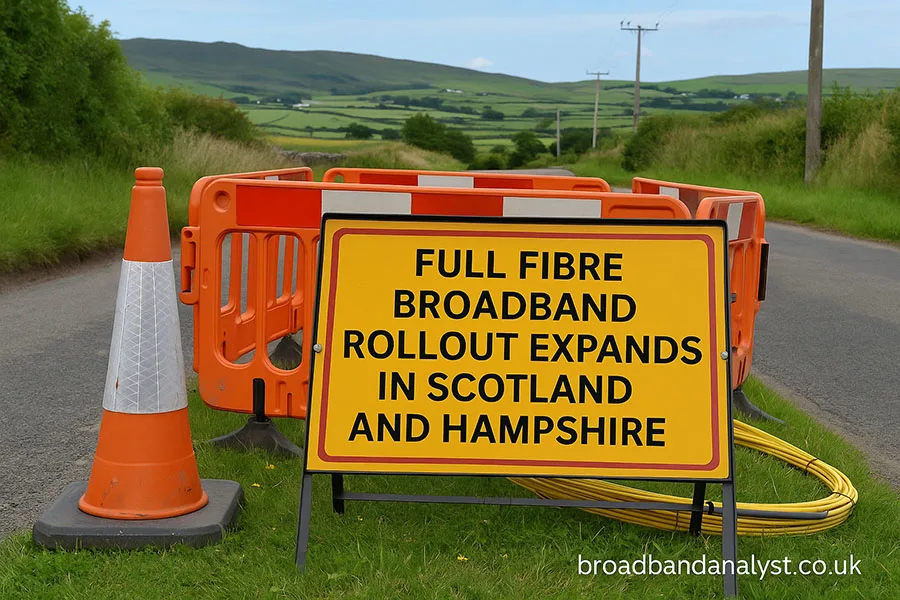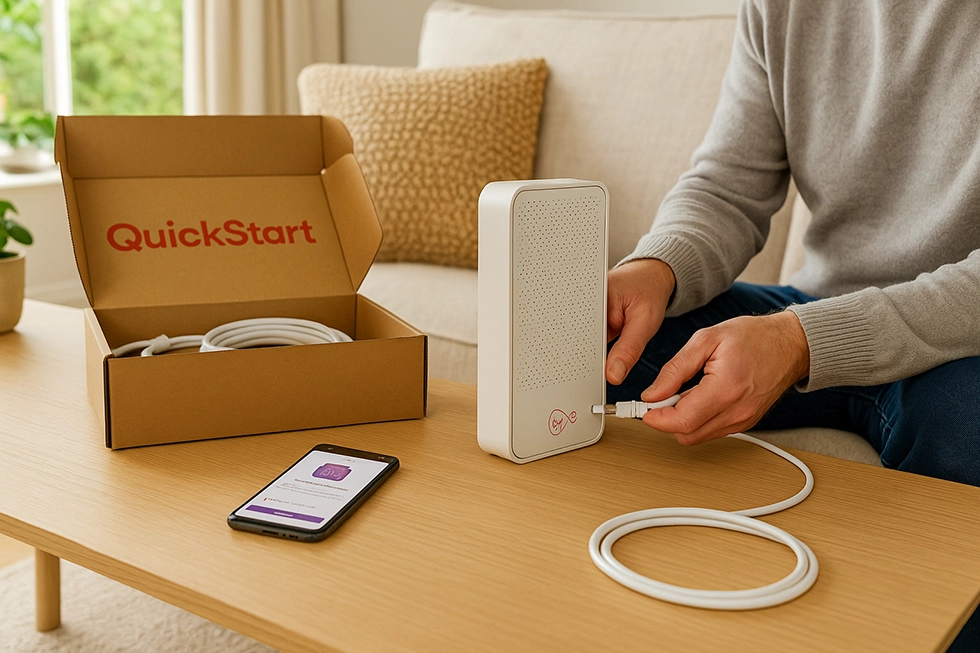The UK’s fibre rollout is gaining pace with two major developments under Project Gigabit. Openreach has secured a £157 million contract to connect tens of thousands of remote Scottish homes and businesses, while CityFibre’s first homes are now live in Hampshire as part of its £104 million contract. These builds target locations that have long suffered from patchy or slow broadband, aiming to bring reliable, high-speed connectivity where it’s needed most.

Both projects highlight how public investment is unlocking digital infrastructure in rural areas where the market alone hasn’t delivered. Together, they represent how the government’s nationwide gigabit push is reshaping broadband access across the UK.
Openreach to Deliver Full Fibre Across Rural Scotland
Openreach has been formally awarded a £157 million contract through Project Gigabit to expand its fibre-to-the-premises (FTTP) network across underserved regions of Scotland. This deal falls under Call-Off 6 of the Type C procurement framework—covering the most remote and commercially unviable areas of the UK.
The focus is on bringing full fibre broadband to around 65,000 rural premises, including the Outer Hebrides, where only about 7% currently have access to gigabit-capable connections. The rollout also includes coverage for the Isles of Skye, Islay and Tiree, as well as isolated mainland communities like Applecross and Durness.
These are places that have typically struggled with slow speeds, long outages, and limited provider options. This new contract aims to change that, using fibre optic connections that can handle gigabit speeds and remain stable even at peak times.
Part of a £800m Procurement Deal
This project is part of a wider £800 million agreement between Openreach and the UK Government under the Single Supplier Framework. That framework was designed to address rural locations that smaller alternative networks (altnets) were unable or unwilling to reach due to high build costs or logistical barriers.
Openreach has already delivered similar rural upgrades in parts of England and Wales, reaching 227,000 premises so far. This Scotland-specific contract builds on that momentum, now bringing high-capacity fibre to some of the most remote properties in the country.
Digital Inclusion and Economic Growth
Telecoms Minister Chris Bryant says this is about more than faster speeds. It’s about ensuring that isolated communities aren’t digitally excluded. “Access to reliable internet shouldn’t depend on your postcode,” he said, adding that rural businesses, students, and elderly residents stand to benefit most.
The government sees this as part of its broader Plan for Change, which aims to ensure digital services and economic growth go hand-in-hand across the UK.
Openreach’s Deputy CEO, Katie Milligan, says the rollout could add £4.4 billion to Scotland’s economy, thanks to increased productivity, support for home-based businesses, and better access to online services.
Project Ties Into Broader Programmes
This new contract is expected to complement Scotland’s R100 broadband initiative, which aims to reach 113,000 premises by 2028 with full fibre. It also follows the earlier success of the Digital Scotland Superfast Broadband programme, which connected over 1 million properties using public investment.
Other recent contracts include a £26.2 million deal with GoFibre to bring fibre to the Scottish Borders and East Lothian—showing that Openreach isn’t the only player, but is currently best positioned to handle the most logistically challenging areas.
Openreach Chosen for Complex Builds
The contract areas covered under this deal had previously received no viable commercial interest, making them difficult to include in standard build plans. Openreach was selected due to its national scale, engineering capacity, and experience building in complex or isolated geographies.
While altnets have led many Type A and Type B contracts across the UK, Openreach remains the core delivery partner for Type C work—handling regions that don’t attract competitive bids.
Uncertainties Around Timeline and Scope
A specific completion date hasn’t been announced for the 65,000 premises. Notably, this is a reduction from an earlier target of over 76,000 homes. The change in scope reflects adjustments to rollout plans following surveys and logistical reviews.
More contracts are expected in 2025 covering Orkney, Shetland, and the east of Scotland. These could go to other providers depending on local bids, but Openreach remains a strong contender for challenging builds.
Broadband in Scotland: Reserved vs Devolved Powers
Although broadband policy is reserved to Westminster, the Scottish Government plays an active role in delivery. Programmes like R100 are funded and coordinated in partnership with the UK Government and Building Digital UK (BDUK).
This cooperative approach is essential for integrating infrastructure and avoiding duplication between projects. As a result, Scotland’s broadband rollout benefits from both national-level investment and devolved-level planning.
CityFibre Begins Rural Rollout in Hampshire
While Openreach builds in the Highlands and Islands, CityFibre has started connecting homes in southern England. The company has gone live with its first customers on Hayling Island, Hampshire, under a £104 million Project Gigabit contract known as Lot 27.
The goal is to reach more than 75,000 premises in rural and hard-to-serve areas, with the full build expected to complete by 2029. These connections are 10Gbps-capable, offering more than enough bandwidth for modern digital life.
A Major Step in the UK Rollout
This Hampshire deployment is one of ten Project Gigabit contracts awarded to CityFibre so far. In total, the company will bring fibre to over 1.3 million additional homes and businesses over the next five years.
It’s a major part of the UK’s push to deliver gigabit broadband to 99% of premises by 2030. Current national coverage sits at around 86%, and CityFibre’s rollout is helping close that gap, particularly in areas where Openreach doesn’t operate.
Extensive Network Investment and Expansion Plans
CityFibre’s full rollout is backed by over £2.4 billion in private equity and nearly £5 billion in debt. Public subsidies from BDUK and Project Gigabit add nearly £1 billion to the mix.
The operator currently has a footprint of 4.4 million premises passed, with 4.2 million ready-for-service (RFS). Its national goal is to reach up to 8 million premises—roughly 30% of the UK market.
Providers on CityFibre’s Network
CityFibre operates as a wholesale-only network, allowing multiple ISPs to offer services over the same fibre infrastructure. These include:
- Vodafone – Key launch partner, offers symmetrical gigabit plans.
- TalkTalk – Offers Future Fibre plans using CityFibre infrastructure.
- Zen Internet – Focuses on high-performance broadband with low contention.
- Giganet, IDNet, Brillband – Provide specialist or premium options.
- Sky Broadband – Set to launch on CityFibre soon.
This open-access model gives consumers more choice and avoids lock-in to a single network operator.
Improving Coverage in Hampshire
The rollout starts with Hayling Island, which has previously lacked widespread fibre access. It will expand into rural areas around Havant and other locations in southern Hampshire.
CityFibre’s commercial investment in towns like Havant runs parallel to the public build, increasing total coverage while sharing infrastructure and deployment resources.
Government Backs Digital Inclusion
Minister Chris Bryant also praised the Hampshire rollout, saying it’s an example of closing the digital divide with real, usable infrastructure. The government’s Digital Inclusion Action Plan aims to ensure everyone—not just urban centres—can access reliable internet.
Fast broadband is now a foundation for work, education, healthcare, and social life. The Hampshire project will help unlock those opportunities for thousands more homes and businesses.
CityFibre’s Strategy for Nationwide Reach
COO Simon Holden has made it clear: full fibre is no longer a luxury, it’s a necessity. He says these builds are about more than speed—they’re about resilience, choice, and future-proofing communities.
CityFibre’s model blends commercial and public builds, allowing them to scale up fast while covering areas that are too expensive for pure market-driven expansion.
What Makes CityFibre Stand Out
CityFibre delivers symmetrical connections—matching upload and download speeds—ideal for cloud users, remote workers, gamers, and families using multiple devices.
Its networks also support ultra-low latency, which improves streaming, video calls, and real-time applications like gaming or virtual classrooms.
Crucially, because the network is open access, ISPs can compete on price and service without duplicating infrastructure.
Financial Stability Backed by Major Investors
CityFibre is owned by a group of heavyweight investors, including:
- Antin Infrastructure Partners
- Goldman Sachs Asset Management
- Mubadala Investment Company
- Interogo Holding
- Newlight Partners
- PATRIZIA’s European Infrastructure Fund II
This gives the company the financial depth needed for long-term builds and national infrastructure planning.
Upcoming Deployment Plans
In Scotland, more Project Gigabit contracts are likely to be announced in 2025, covering Orkney, Shetland, and the eastern mainland. In England, CityFibre’s Hampshire project will continue to expand across the county in stages.
As both Openreach and CityFibre extend their networks, the number of households able to choose full fibre from multiple ISPs will rise—bringing better speeds, more reliability, and a fairer market for everyone.
